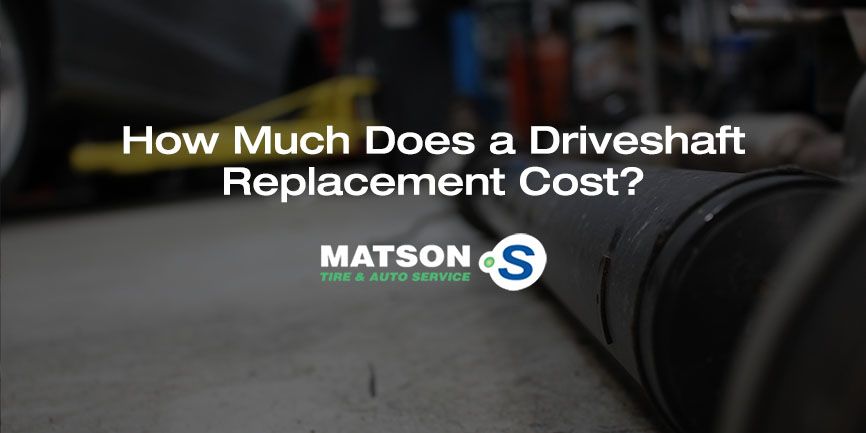How Much Does It Cost To Fix A Driveshaft

The driveshaft, a seemingly simple component responsible for transmitting power from the engine to the wheels, faces a complex future. Its repair costs, traditionally a straightforward affair, are about to be redefined by the accelerating evolution of automotive technology. Today, we'll examine the current landscape of driveshaft repair expenses and project how electric vehicles (EVs), hybrid systems, and smart automotive solutions will reshape this facet of vehicle maintenance.
The Current Cost Landscape: A Familiar Tune
Currently, driveshaft repair costs vary significantly based on the vehicle's make, model, and the nature of the problem. A simple U-joint replacement might set you back a couple of hundred dollars, while a complete driveshaft replacement could easily run into the thousands. Labor costs, of course, play a significant role, and the complexity of accessing the driveshaft can dramatically inflate the final bill. Corrosion, damage from road debris, and wear and tear on the supporting components, such as the center support bearing, are the most common culprits. These familiar issues will, to some extent, persist.
The Electric Revolution: A Drivetrain Rethink
The rise of EVs presents a fundamental shift. Many EVs, particularly those with independent rear-wheel drive or all-wheel drive, eliminate the long, single-piece driveshaft. Instead, they employ electric motors directly connected to the wheels or axles. This means that the traditional driveshaft, with its associated maintenance costs, simply vanishes. However, this doesn't eliminate driveline maintenance altogether. EVs introduce new components requiring attention, such as the electric motors themselves, gearboxes (often single-speed), and power electronics. The cost of repairing or replacing these EV-specific components is currently a relative unknown, but initial estimates suggest they could be substantial, particularly for battery-related issues that indirectly affect drivetrain performance.
Furthermore, the move to in-wheel motor technology would further refine cost considerations, but the complexity of servicing these motors remains a challenge. Accessibility for mechanics is a key design consideration for the future.
Hybrid Systems: A Complex Interplay
Hybrid vehicles, with their combination of internal combustion engines and electric motors, present a more nuanced picture. Some hybrids still utilize a conventional driveshaft, particularly those with all-wheel drive that supplements the front wheels driven by the engine. In these cases, traditional driveshaft repair costs will remain relevant. However, other hybrids may use a combination of a conventional drivetrain for one axle and an electric motor for the other, reducing the length and complexity of the driveshaft. This could potentially lower the frequency of repairs and, therefore, overall costs. The complexity of hybrid powertrains, however, means that diagnosing and repairing driveline issues can be more challenging, potentially increasing labor costs. Software integration and communication between the electric and combustion components will become crucial areas for maintenance and repair.
Smart Automotive Solutions: Predictive Maintenance and Autonomous Driving
Smart automotive solutions, including advanced driver-assistance systems (ADAS) and eventually autonomous driving technology, will have a profound impact on all aspects of vehicle maintenance, including driveshaft repair. Predictive maintenance, using sensors and data analytics to identify potential problems before they occur, could significantly reduce the frequency of catastrophic driveshaft failures. By monitoring vibrations, temperature, and other key parameters, the system can alert the driver or service technician to potential issues, allowing for proactive repairs that are far less expensive than dealing with a complete breakdown. Furthermore, the smooth and precise driving style of autonomous vehicles could reduce stress on the drivetrain, further extending the lifespan of the driveshaft and related components. However, reliance on these systems also brings new challenges. Software glitches, sensor failures, and cybersecurity vulnerabilities could all lead to unexpected breakdowns and potentially higher repair costs.
Challenges Ahead: Skill Gaps and New Technologies
The transition to EVs and advanced automotive technologies presents significant challenges. Mechanics will need to acquire new skills to diagnose and repair electric motors, power electronics, and complex software systems. Traditional automotive training programs will need to adapt to these evolving needs. Furthermore, the cost of specialized tools and equipment for servicing EVs could be substantial, potentially increasing the cost of repairs in the short term. The industry also needs to address the environmental impact of battery production and disposal. Sustainable practices and recycling programs will be essential to ensuring the long-term viability of electric mobility.
Despite these challenges, the future of mobility is bright. EVs offer the promise of cleaner, more efficient transportation, while autonomous driving technology has the potential to revolutionize our cities and improve road safety. As technology continues to evolve, the way we fix our cars, including components as fundamental as the driveshaft, will adapt alongside it. The move to electrification means fewer moving parts in some instances, and greater integration in others. Software analysis will become as important as a wrench.
A Visionary Note: Mobility as a Service
Looking further ahead, the concept of personal vehicle ownership may evolve into a "mobility as a service" (MaaS) model. In this future, individuals will no longer own cars but instead subscribe to a transportation service that provides access to a variety of vehicles, tailored to their specific needs. In such a scenario, the responsibility for vehicle maintenance, including driveshaft repair, will shift from the individual to the service provider. This could lead to economies of scale and more efficient maintenance practices, potentially lowering the overall cost of transportation for everyone. Imagine a fleet of AI-managed vehicles that self-diagnose and schedule their own maintenance appointments. The future of mobility is not just about electric cars and autonomous driving; it's about rethinking the entire transportation ecosystem. And while the humble driveshaft, in its current form, may fade into automotive history, the need to efficiently transmit power to the wheels will remain a fundamental challenge, driving innovation and shaping the future of mobility for generations to come.
